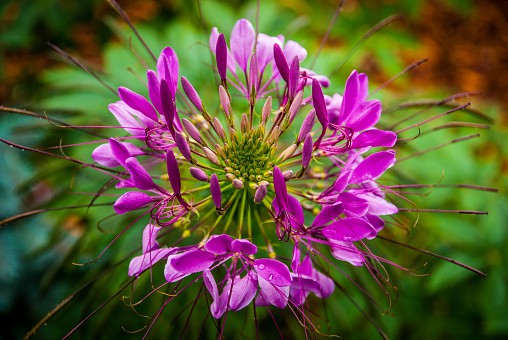The Cleome Hassleriana, also known as spider flower, is a fast-growing annual that normally produces large airy clusters of small flowers. These flowers have long spiky stamens, giving them a spider-like look. This flower typically comes in purple, pink, and white hues, and is highly fragrant. The Cleome Hassleriana will typically bloom from summer up to the first frost. Dried seed heads also provide nourishment for birds in the winter. While requiring some basic care, these flowers look best when planted in groups of at least six.
Etymology
This genus was named by Carl Sigismund Kunth in 1820 in honor of his mentor Caspar Georg Carl Reinwardt, professor at the University of Amsterdam. The common name ‘Spider Flower’ comes from the plant’s spider-like, many-petalled flowers, which decorate the plant throughout the summer. The alternate old common name “Wild Balsam” is derived from the Latin family name for the species, BALSAMINACEAE.
How to Plant and Grow
Cleome Hassleriana are an incredibly easy plant to grow and are also quite low-maintenance. They prefer full sun to partial shade in order to get the best of its flowers. These flowers prefer to be planted in well-draining, lightly acidic soil with a pH level between 6.0-7.0. They will tolerate a range of temperatures, from 40-90 degrees Fahrenheit, and require a medium amount of water. Fertilize your Cleomes with a balanced 10-10-10 fertilizer at least once a year. Be sure to not over-fertilize, as this can be harmful.
Meaning and Symbolism
The Cleome Hassleriana symbolizes “magical grace” and is believed to enhance intuition, creativity and understanding of the unknown. Its beauty and unique features make this flower a perfect way to express admiration and positive feelings. The spider flower makes a great gift for anyone you care to show kindness to.
History, Mythology and Religious Significance
In many cultures, the spider flower has long been associated with romantic love and beauty. The ancient Romans typically gave the Cleome flower to their gods during ceremonies, as a token of their fondness and appreciation. Additionally, some African tribes believed that the Cleome flower warded off evil spirits and brought prosperity. In the United States, Cleome often is used in weddings as the fine details in bouquets and decorations, its beauty and simple grace making it a perfect addition for such occasions.
Flower Varieties and Their Defining Characteristics
The Cleome Hassleriana belongs to the plant family Balsaminaceae, and is classified as an annual plant. There are many varieties of the Cleome flower, all with unique characteristics. Some of the most popular varieties include the Bouncing Bet, Blushing Bride, Summer Dance, and Giant White Cleome. Some of the defining characteristics that often differentiate the flower varieties include flower color and size, foliage color and height, as well as intensity of the sweet-scented aroma.
How to Pot and Repot
When potting and repotting the Cleome Hassleriana, it is important to use a deep pot with adequate drainage. A pot with a diameter that is at least 10” deep is recommended. Be sure to use soil that will allow adequate drainage while still allowing the soil to hold moisture. Place the seedling in the pot and backfill with soil before packing it down lightly. Water the seedling and place it in an area with bright, indirect light.
How to Prune
The Cleome Hassleriana needs to be pruned regularly in order to grow to its full size. Pruning should be done in late winter and early spring before the buds begin to bloom. To ensure the flowering will fill out, you should remove the flower stems below where the flowers start to bloom. After pruning, you should fertilize the plant just before it blooms for an extra boost. Additionally, you should deadhead any old flowers to promote new growth.
How to Propagate
The Cleome Hassleriana is most easily propagated using potted cuttings, or stem cuttings. Choose stems that are strong and healthy and make a cut below a node and beyond any flower buds. Remove any leaves from below the cutting and dip the cut end into rooting hormone before placing the cutting into a pot filled with potting mix. Water lightly and then cover the pot with a plastic bag to help the cuttings retain moisture. Place the cutting in indirect sunlight and check the progress of the cuttings by lightly tugging the stems after a few weeks. When the cuttings have rooted, you can begin to care for them as you would any other Cleome.
Common Pests and Diseases
The Cleome Hassleriana is generally pest-free and is also resistant to most diseases. In rare cases, however, common plant diseases like powdery mildew and rust can affect some plants. To prevent these diseases, regular soil maintenance is necessary; be sure to use a fertilizer and soil that will contain proper nutrients for the plant. Additionally, it is important to avoid over-watering the plant, as this can cause disease and mold to occur.
FAQs About Cleome Hassleriana
Q: How tall do Cleome Hassleriana typically grow?
A: The Cleome Hassleriana typically grows to a height of 4-6 ft.
Q: What color varieties are the most popular?
A: The most popular varieties are the pink and purple hues, with white being common as well.
Q: What is the bloom period for this flower?
A: The bloom period of the Cleome Hassleriana is from summer up to the first frost.
Table Fact Sheet
| Spider Flower | Cleome Hassleriana |
|---|---|
| Family | Balsaminaceae |
| Plant Type | Annual |
| Mature Size | 4-6 ft. |
| Sun Exposure | Full Sun – Partial Shade |
| Soil Type | Well-Draining/Lightly Acidic |
| Soil pH | 6.0-7.0 |
| Bloom Time | Summer to first frost |
| Flower Color | Purple, Pink, White |
| Hardiness Zones | Varies; dependent on variety |
| Native Area | South America |
What we love from Amazon this week
Buy these wonderful flowers directly from Amazon:















